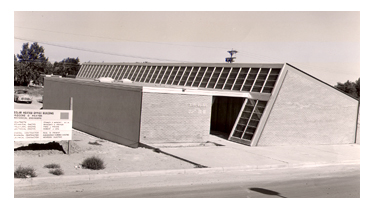

No timeline of solar energyís history will be complete without reference to the first commercial solar building, built in 1956, by mechanical engineers Frank Bridgers and Don Paxton at 213 Truman N.E. in Albuquerque, New Mexico.
Life magazine, then one of the most popular American consumer magazines, devoted several pages to it in their Dec. 17, 1956 edition. They referred to it as an ìodd-looking new office building "[that] has one wall sheathed in glass and tilted to face the sun."
The architecture of the Bridgers and Paxton (B&P) Solar Building followed its function. It was designed with a dominant south-facing wall slanted back at 30 degrees to better capture New Mexicoís intense sunlight. Designing buildings to capture the heat of the sun is not new. It has been an element of traditional architecture as far back as Roman times. It is now called "passive solar design."
What made this building truly different was the combination of active mechanical components that worked along with the physical design of the building, to create a five-phase system. The system was managed by a panel of pneumatic controls that in a modern building would be computerized on a microchip. But such things did not then exist.
The B&P Solar Building was designed and built at a time when most mathematical calculations were still done with slide rules, as the only computers were "mainframes" serving the government and major corporations. This solar-heated office building, in 1956, was completely revolutionary.
News of the building appeared in dozens of consumer and engineering magazines worldwide, including Popular Science, Popular Mechanics, in addition to Life. With one major renovation in the 70s, the system worked for most of the 30 years that Bridgers and Paxton Consulting Engineers occupied the building.
Now abandoned in place, the building's system served well as a prototype that was easily 15 years ahead of its time. Its heat pump and thermal storage components have proved themselves even more effective than the solar thermal elements in energy efficient systems for large commercial and institutional buildings.
Both Frank Bridgers and Donald Paxton have passed on. Bridgers died in the spring of 2005 at age 83 and Paxton in the summer of 2007. He was 95.
Bridgers and Paxton Solar Building Brochure
50th Anniversary Celebration Announcement